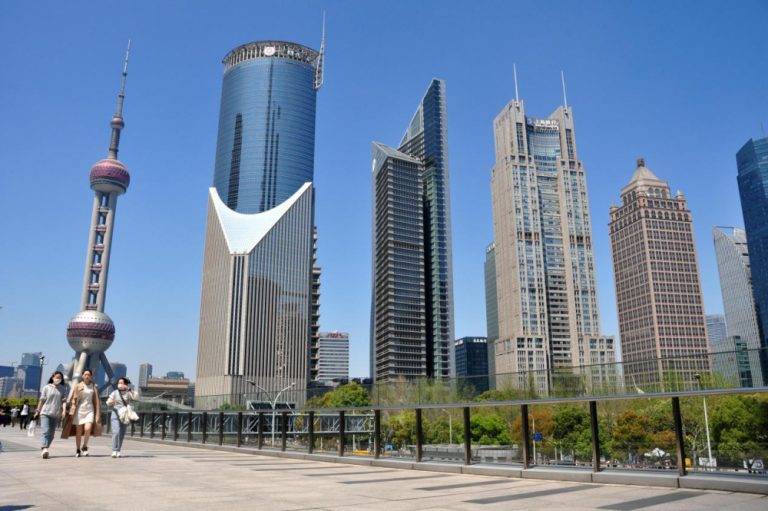
By Xie Weiqun, People’s Daily
Shanghai has made breakthroughs in building itself into a global financial center over the recent decade, with surging financial transaction volumes, an improved market structure, and constantly strengthened core economic functions. The city is playing a more critical role as a hub of the opening-up of China’s financial sector.
The added value of Shanghai’s financial industry hit 862.7 billion yuan ($120.44 billion) last year, accounting for 19.3 percent of the city’s GDP in the same period.
The growth of the industry came from its strengthened core functions.
Financial factor markets play a core role in building an international financial center. Shanghai is one of the cities in the world that boast the complete economic factor markets, where currency, stocks, bonds, future goods, foreign exchange, gold, insurance, trust, and other financial sectors can all be traded.
The total volume of transactions in Shanghai’s financial markets reached 2932.98 trillion yuan, up 16.8 percent yearly. The growth rate increased by 6.4 percent.
Last year, the Shanghai Stock Exchange ranked first worldwide regarding the total amount of initial public offerings. Besides, Shanghai was also the third largest trading hub in the world for spot gold and crude oil futures.

Getting listed is a crucial step for sci-tech and innovation firms to grow bigger. The Shanghai Stock Exchange’s sci-tech innovation board, also known as the STAR market, is working to straighten the “last mile” for sci-tech and innovation companies planning to go public.
As of the end of May this year, 528 companies were listed on the STAR market, which had raised 822.36 billion yuan ($114.73 billion) through initial public offerings. Their market value added up to 6.7 trillion yuan. The capital market’s efficiency in serving the real economy has been constantly improved.
The capacity and volume of capital management are other essential factor in evaluating the construction of an international financial center. Shanghai has made significant progress in strengthening global capital management.
Capital management is considered a bridge between the real economy and financial capital. Shanghai, placing high importance on developing the capital management industry, vowed two years ago that it would build itself into an essential hub of capital management in Asia and one of the leading centers of capital management globally by 2025.
So far, the city has made progress in capital management development—the asset under management in Shanghai account for around a quarter of the national total, and in particular, publicly offered funds and insurance assets make up 1/3 of the capacity in China, and equity funds 1/2. Besides, Shanghai also leads in the volume of privately offered fund management.
Shanghai is home to a batch of top-tier asset management institutions. It sees an increasingly enriched system of asset management products and rich human resources in the financial sector.
Thirty-two of the 38 foreign-owned private equity fund management firms registered at the Asset Management Association of China are in Shanghai, and 17 of the top 20 asset management companies worldwide have set up entities in Shanghai.
Besides, BlackRock, the first global asset manager licensed to start a wholly owned onshore mutual fund business in China, as well as J.P. Morgan Securities (China) Company Limited, the first foreign public fund manager to gain full ownership over its Chinese joint venture, are also headquartered in Shanghai.
Shanghai is enhancing its efforts to build an international center of green finance to contribute to China’s goal of peaking carbon dioxide emissions before 2030 and achieving carbon neutrality before 2060.
“Over the recent years, Shanghai has been a forerunner in the country in innovation in green financial products, the introduction of key organizations and platforms, and relevant international cooperation and exchanges,” said Liu Liya, Assistant to President at the Shanghai University of Finance and Economics.
As a city that gathers financial markets, Shanghai has always made innovations in green financial products and services. For instance, China’s first low-carbon transition bonds were issued on the Shanghai Stock Exchange. In addition, a series of carbon-efficient indexes were launched in the city, including the Shanghai Stock Exchange 180 Carbon Efficient Index and the Shanghai Stock Exchange Shanghai Environment and Energy Exchange Carbon Neutrality Index. Last year, Shanghai’s Pudong New Area became the first pilot zone in China for climate investment and financing.
Building a multi-level system of green financial organizations and institutions, Shanghai is working to improve its green financial services. 2020 the National Green Development Fund was inaugurated in Shanghai, focusing on green and low-carbon development in crucial areas. Besides, financial institutions in Shanghai have successively established specialized departments or teams for green finance. As of the end of 2022, the balance of green loans of Shanghai’s financial institutions totaled 842.39 billion yuan, up 39.4 percent year on year, 32 percentage points higher than the growth of other loans in the same period.
Shanghai is steadily building an international financial center by strengthening capabilities in serving real entities, creating an essential asset management hub, and reforming and innovating green finance.
Shanghai will further enhance global resource allocation, make its financial market, institution, and infrastructure systems more competitive globally, and improve the financial sector’s capability and efficiency in serving the real economy, said an official with the Shanghai municipal government.
The official added that the city would also build a virtuous cycle among technology, industry, and finance, prudently and actively deepen reform, expand opening up in the financial sector, and create a competitive and attractive economic ecology.










